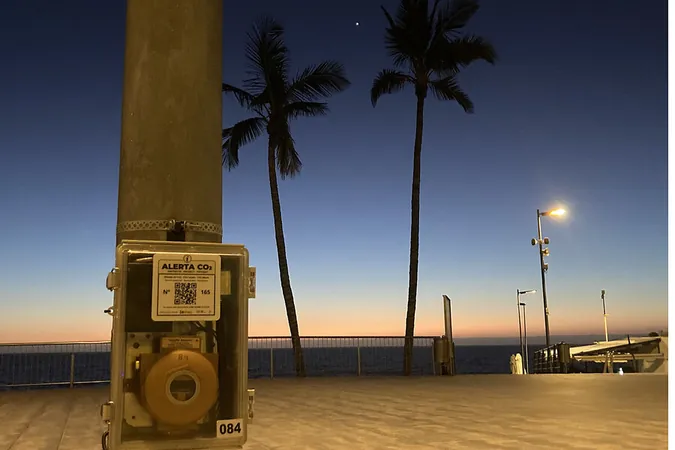
High-Tech Sensors Save Villagers from Volcanic CO2 Threats in the Canary Islands
2025-04-14
Author: Wei
Beneath the sun-drenched skies of the Canary Islands, a seemingly typical beach day unfolds. Tourists bask on the shores and children laugh as they splash in the waves. But this picturesque scene masks a dramatic tale of peril and innovation.
The Eruption That Changed Everything
For two long years, Puerto Naos—a scenic haven on La Palma—remained eerily deserted. Businesses stood empty, displaying signs warning of danger. The shift came after Cumbre Vieja volcano erupted in September 2021, unleashing lava towards the village and leading to the evacuation of over 1,000 residents.
The Hidden Struggle with CO2
In the aftermath, scientists uncovered a more insidious threat—hazardous levels of carbon dioxide (CO2) had been released into the air from the soil below, with concentrations soaring to a staggering 480,000 parts per million, a level more than 400 times above acceptable limits.
Nemesio Pérez, a scientific coordinator at Involcan in Tenerife, remarked on the dire scene: “There were dead birds and cats strewn across streets. That was our wake-up call.”
Innovating Safety: Project Alerta CO2
Collaborating with Spanish authorities, Pérez spearheaded a groundbreaking initiative called Alerta CO2—a €4 million project, the first of its kind to deploy a vast network of CO2 monitors. Today, Puerto Naos and La Bombilla boast over 1,300 detectors, making them the world’s most closely monitored areas for gas emissions.
A Return to Normalcy
This innovative monitoring project allowed approximately 80% of previous homeowners to safely return. The mayor of Los Llanos de Aridane, Javier Llamas, emphasized, “People shouldn’t have to worry about simply breathing clean air.”
Hotel Operations Amidst Caution
The renowned Meliá La Palma hotel, Puerto Naos’ sole lodging, faced uncertainty post-eruption. But with 55 CO2 detectors installed discretely throughout the premises, it has reclaimed its stature, operating at full capacity. Hotel manager Irving Ribot noted, “We assure our guests they are under constant monitoring.”
Round-the-Clock Vigilance
In a makeshift office located in an elementary school, the Alerta CO2 team, led by project coordinator Marisol Gonzalez, monitors real-time data from every household in the area. They maintain a constant watch, ready to alert residents of rising CO2 levels.
The Gradual Comeback of Puerto Naos
Although it’s unclear how long this CO2 release will continue, levels have started to decline, permitting over 900 homes and businesses to reopen. Margaret Pérez, a lifelong local, expressed her determination to return despite others opting for larger towns. “Not me. I love it here,” she proclaimed.
Navigating Ongoing Risks
Certain areas still remain off-limits, with caution signs peppering the landscape. Meanwhile, the La Palma regional government introduced the Smart Island app, allowing residents to monitor outdoor CO2 levels in real time. Local business owners, like hairdresser Maria Malik, work diligently to reassure clients, although concerns about CO2 levels persist.
As Puerto Naos bounces back, its residents embrace not only a return to normalcy but also a beacon of hope amid danger—a pioneering solution that could offer a blueprint for communities facing similar environmental challenges.



 Brasil (PT)
Brasil (PT)
 Canada (EN)
Canada (EN)
 Chile (ES)
Chile (ES)
 Česko (CS)
Česko (CS)
 대한민국 (KO)
대한민국 (KO)
 España (ES)
España (ES)
 France (FR)
France (FR)
 Hong Kong (EN)
Hong Kong (EN)
 Italia (IT)
Italia (IT)
 日本 (JA)
日本 (JA)
 Magyarország (HU)
Magyarország (HU)
 Norge (NO)
Norge (NO)
 Polska (PL)
Polska (PL)
 Schweiz (DE)
Schweiz (DE)
 Singapore (EN)
Singapore (EN)
 Sverige (SV)
Sverige (SV)
 Suomi (FI)
Suomi (FI)
 Türkiye (TR)
Türkiye (TR)
 الإمارات العربية المتحدة (AR)
الإمارات العربية المتحدة (AR)